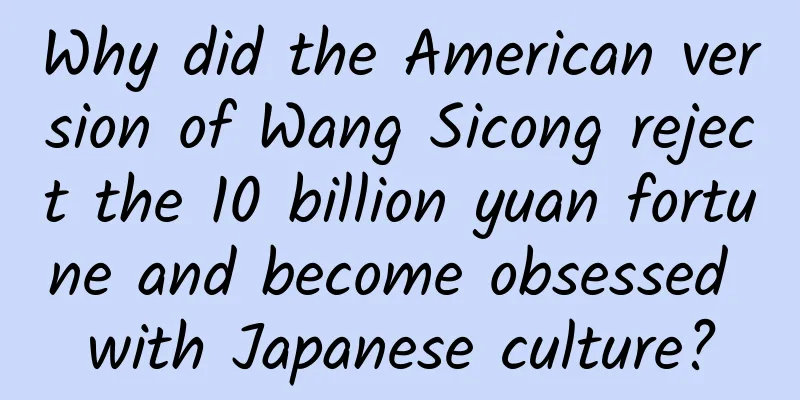Why did the American version of Wang Sicong reject the 10 billion yuan fortune and become obsessed with Japanese culture?

|
For many viewers, the "enlightenment" of stop-motion animation began with a batch of popular puppet animation works produced by Shanghai Animation Film Studio. With the gradual exposure to overseas works, from the widely circulated "The Nightmare Before Christmas", to "Corpse Bride" and "Curse of the Were-Rabbit" nominated for the Oscar for Best Animated Feature in 2006, to "Coraline" and "Fantastic Mr. Fox" nominated for the 82nd Academy Award for Outstanding Animated Feature. It can be said that stop-motion animation has long been recognized and paid attention to in the mainstream animation circle.
Although computer 3D animation currently dominates the mainstream, stop-motion animation, with the convenience of the times, has become more common and popular than ever before, becoming a hot film category. To this day, stop-motion animation is constantly improving itself in the siege of the CG animation industry, while leveraging its strengths, constantly learning from and integrating emerging technological factors. Almost every work can achieve unprecedented "success" in the reputation and evaluation of the industry and outside.
There is a kind of animation that loses money but still makes a lot of money Stop-motion animation is one of the oldest forms of expression, dating back to the Stone Age 25,000 years ago. Since Pixar Studios started 3D production in the late 1990s, stop-motion animation (especially feature-length) has been considered an "alien" form of creation in the industry chain. With every release of a work, it is very likely to end up with a balance between income and expenditure. The reason why it can still tenaciously forge its own path and gain wide recognition in the continuous breakthrough and innovation is not only due to the popularity of audiences and media reviews, but also because of the passionate, persistent and willful creators in the industry like Laika Entertainment.
In fact, Hayao Miyazaki's "re-employment" is ultimately due to this pursuit. It is precisely because of the stubbornness of these practitioners that we can see exquisite and high-quality stop-motion animation works like "Kubo and the Two Strings" in our lifetime.
Putting aside the often-criticized plot bugs and logical flaws, these are the only regrettable flaws . The difference between "Kubo and the Two Strings" and the time-consuming nature of traditional production is that it has proposed a new production method in terms of technology: physical models + digital special effects + 3D printing. The faces, eyes, lips, etc. in the movie were designed in advance and then printed out through 3D. In actual shooting, the characters need to constantly change their body movements and facial expressions as the plot develops. There are 24 frames per second. In one second of the picture, the staff needs to take at least 24 photos (actually more, 24 photos are selected). In a continuous action of up to 10 seconds, the number of photos that need to be taken is astonishing. So although 3D printing has improved efficiency, it has not reduced the workload at all.
For the character of Kubo alone, the crew created 23,187 facial models for him, including 11,007 mouth expressions, 4,429 eyebrow expressions, and other accessories such as hair, which can be combined to create more than 48 million facial shape changes.
"If you must blink, do it now!" This line that appears frequently in the film perfectly summarizes the audience's viewing experience of this film. The stop-motion animation system has created a unique aesthetic space for it with its incomparable element levels and more realistic scene performances that mainstream animation cannot match. It has become a proud asset and selling point that attracts audiences who have been spoiled by Disney's narrative performance to try new and exciting things. As a result, the audience evaluates many well-made stop-motion animations as "every frame is art." It's so wonderful that you can't bear to blink. It seems that both the producers and the audience are full of deep meaning from the heart.
This movie was released at a time when many blockbuster movies were released, so the box office was not very good. But when we found that "Suicide Squad" was more disappointing than expected, the Jason Bourne myth was no longer there, and the routines of superheroes and sequels were boring, "Kubo and the Two Strings" made people feel a long-lost breath of fresh air from Japan with its outstanding story and beautiful pictures.
In addition to the exquisite scene design, the powerful voice acting lineup is also a guarantee of word of mouth. This film perfectly combines Western family themes with Japanese painting styles, and has a Rotten Tomatoes rating of 97%. It has also jumped to the same level as "Zootopia" and won the 2017 Oscar for Best Animated Feature Film. The most popular contender is a geek known as the American version of "Wang Sicong": Travis Knight. You may be unfamiliar with this name, but with the hint of "Wang Sicong", I believe you can guess it almost right. His father is Phil Knight, who built the Nike empire. Travis Knight
Phil Knight Yes, that's him! Yes, it's the same guy! The past extravagance and lust have created the peak of geeks today Today, as the industry's top stop-motion animation representative: CEO of Laika Studios, Travis Knight was actually no different from other rich young masters in his early years. He was just a rich second-generation who hated sports, did not work, and lived a life of ease and idleness all day long. If Travis Knight were to recall the origin of his entry into this circle, it would probably be when his mother read him The Lord of the Rings. When the Nike empire was just being established, his father was often away from home, so JRR Tolkien, CS Lewis and L. Frank Baum became Travis' cherished companions. Through his mother's guidance, the little boy's childhood was opened to a portal to another world (he was inadvertently enlightened by the originator of fantasy literature). A trip to Japan with his father when he was a child gave him a dreamlike experience. Everything in Japan fascinated him, including Ukiyo-e, Kinkakuji Temple, kimonos and shamisen... and even Zen culture, which later became his lifelong love and influenced his outlook on life. Rather than saying that he fell in love with stop-motion animation, it is better to say that he fell in love with creation itself. The creative process of turning imagination into reality and creating something from scratch is the most fascinating part for him. A movie called "Jason and the Argonauts" made him want to do it for the first time. After that, Travis finally got his wish. He not only studied stop-motion animation professionally but also established Will Vinton Studio. After the "9.11" incident, the situation of the studio took a sharp turn for the worse. In order to save the fate of the studio, or his son's dream, Phil Knight directly bought the studio and became the largest shareholder, but on the condition that Travis Knight would become the main decision-maker of the company. In 2005, the studio was renamed Laika. At that time, Travis, who had become one of the main animators in the studio, successfully became the head. Later, he recalled that when he talked to his father, his father said something that now seems to be full of Zen: "Listen to the call of your heart and do what you are destined to do." Travis did not disappoint Phil. The reborn Laika was clearly positioned as a studio specializing in stop-motion animation, and at this time he was not only the head of the entire studio, but also the chief animator. No one understood the importance of "balance" better than him. We can perhaps understand the philosophy of Laika Studios as a geek spirit, not to mention that Travis Knight has been a typical geek from beginning to end. In order to truly restore the oriental aesthetics, all the staff of the Laika studio went to Japan to learn about traditional Japanese philosophy. The costume designers not only looked for fabrics and colors that are unique to Japan, but also the dance movements of the puppets in the Obon Festival were designed by a 90-year-old Japanese dance choreographer. In addition, Travis and his team paid tribute to the two Japanese film masters he most respected in this film, Akira Kurosawa and Hayao Miyazaki. The works of Laika Studio may only represent another level of deep processing in the mainstream creation of marketization. At the same time, although it cannot be called a clear stream, it can be regarded as a new stimulation to the increasingly tired traditional creation. The use of small humor in "Kubo and the Two Strings" is different from the lively American shit and fart jokes. There are only nonsensical jokes that are more suitable for Eastern style throughout the plot, which makes the audience feel cute inadvertently. After this battle, Laika Studio has become synonymous with stop-motion animation, and it competes with Hollywood animation giants with exquisite pictures and sincerity that cannot be replicated by computers. Can the efficiency of a work in two or three years compete with the industrial assembly line? The answer is unknown, but in Travis' words, Laika is full of vitality and it is not afraid of challenges. No problem The sexy shamisen brings out the innovation of the perfect blend of tradition and modernity The most important quality of a geek is the spirit of adventure. It is not easy to stick to the tradition of stop-motion animation in Hollywood, where efficiency is paramount, because this art form requires concentration, rigor and patience. Slow work is its synonym.
Compared with the traditional stop-motion animation shooting method, we can find that every time a stop-motion animation is shot, in order to meet the needs of the plot, the producers rack their brains to develop new methods, meet various challenges, and conduct various experiments to achieve the best picture effects. Today's stop-motion animation production is more complicated than shooting live-action movies, from CG special effects, post-synthesis, 3D printing applications to art design and story innovation support. The material application form of stop-motion animation is constantly innovating with the advancement of the times and technology, and its creative connotation and application field are also changing accordingly. This traditional skill has now been pushed to a higher level, creating a new stop-motion animation model in the digital age. If we analyze the trend of stop-motion animation in recent years in the context of the new era from the perspectives of story innovation and visual effects, it is not difficult to find that early works such as "Corpse Bride" and "Frankenweenie" that bring together Tim Burton's Gothic core, "Fantastic Mr. Fox" that wins with storytelling, or "Anomalisa" that realistically explores the life of a man in the midlife crisis. All of these are enough to show the diversified expression possibilities of stop-motion animation styles.
As for the creation of stop-motion animation in my country, since the late 1980s and early 1990s, with the sudden collapse of the "Chinese School" animation. Therefore, in the 1980s, Chinese films could not face the impact of the market environment. The Shanghai Animation Film Studio transformed into a high-income OEM, and the original work was interrupted. As a result, the Chinese animation industry has been in a slump and it is difficult to develop. At that time, this also made many Japanese animators who once regarded Chinese animation as a learning object feel distressed, and Hayao Miyazaki was one of them. Although there is no hope of forming an industry, for most people born in the 1980s, the occasional stop-motion works such as "Magic Brush Ma Liang" and "The Story of Afanti" produced by Shanghai Animation Film Studio are still fresh in their memory. Now it seems that although these creations are relatively simple in form, each one is a rare and wonderful work in terms of story and production.
In the current situation of the Chinese market where the creation is full of stylized and special effects, the spirit of making an original animation is already very valuable, and the spirit of making an original stop-motion animation is even more valuable. In addition, for long-form stop-motion animation, it is indispensable, the cycle is long and the results are minimal. Probably in China, it is generally only in the creation of experimental or commercial short films.
Please note that the above picture is just for show In short, stop-motion animation is completely unsuitable for the current Chinese industry, which has an excessive demand for efficiency and returns. Even in overseas markets, stop-motion animation creation is "scarce". Although it has a unique texture and expressiveness that CG cannot simulate and restore. However, the production of a film requires the concerted efforts of hundreds of people. It is considered high efficiency to complete 2 seconds of animation every day, and there is unimaginable heavy labor and extremely fine workmanship hidden in the middle.
Tim Burton said this when he insisted on using stop-motion animation: "This is a mode that requires animators to move dolls to tell stories, and it has become the basic factor that makes us so addicted. These handmade things have an indescribable charm, and the only thing we have to do is to return everything to simplicity and plainness, and then watch their movements change little by little with excitement, becoming one vivid character after another. When you move them, you can feel a wonderful energy being transmitted very specifically, just like the first time you see Van Gogh's paintings. Although you have seen them in the book, when you really look at them, you still can't express them, or they are not something that can be expressed in words at all. This is a state that computers can never achieve. This almost magical feeling is simply unstoppable."
All those who make stop-motion animation have a similar deep affection for it, and a deep love for this form of storytelling that has been accumulated over the years. This is exactly the real charm of stop-motion animation for the participants who are engaged in the creation. These people who love stop-motion animation believe that telling bold, unique and immortal stories can move the world. The continuous enthusiasm and perseverance exuded by these individuals in the chain is an enduring driving force, driving the industry to move towards a stronger, cooler and more awesome direction. The picture below is just to express a kind of persistent willfulness! It has nothing to do with this article! It has nothing to do with me! I hereby declare! As a winner of Toutiao's Qingyun Plan and Baijiahao's Bai+ Plan, the 2019 Baidu Digital Author of the Year, the Baijiahao's Most Popular Author in the Technology Field, the 2019 Sogou Technology and Culture Author, and the 2021 Baijiahao Quarterly Influential Creator, he has won many awards, including the 2013 Sohu Best Industry Media Person, the 2015 China New Media Entrepreneurship Competition Beijing Third Place, the 2015 Guangmang Experience Award, the 2015 China New Media Entrepreneurship Competition Finals Third Place, and the 2018 Baidu Dynamic Annual Powerful Celebrity. |
<<: Will the car market still need purchase tax preferential policies next year?
>>: Audi and dealers reportedly broke off talks
Recommend
Operators should use VoLTE to compete with WeChat Phonebook
Operators invest hundreds of billions of yuan eve...
A 6-year-old boy was infected with a rare "brain-eating worm" while swimming at the beach! There is currently no specific medicine, and the mortality rate is as high as over 90%!
"My original intention was to take my child ...
How to build various user incentive systems?
User operation is to add a suitable user incentiv...
How can a UI designer who has been working for one or two years and is still standing still advance in his studies?
As you all know, for a long time we have been ins...
Want to show off your grapefruit diet? Don’t be blind, listen to what the experts say
Now is the season for grapefruit, which is a grea...
Video websites have successively established film companies to fight against the shift to the big screen
After iQiyi and Huace Film & TV jointly annou...
The neglected soil is inextricably linked to our human health | Chen Nengchang
April 22nd of every year is Earth Day, a festival...
A strange "dandelion" in the universe? The mystery of the supernova remnant Pa30
Author: Duan Yuechu and Huang Xianghong Deep in t...
Baidu search CPC/eCPC/oCPC in one article
When promoting, many students often cannot distin...
After analyzing the pain points of 100 copywriting articles, we found that 99% of them are not really painful!
I have recently collected some articles about cop...
B station’s precise traffic layout method!
In the past two years, friends who have made shor...
Just now! Typhoon "Ma'an" landed in the coastal area of Dianbai, Guangdong, please take precautions!
Around 10:30 a.m. , this year's ninth typhoon...
Inside the Guanghan Palace, Chang'e-3 continues to create new miracles - Chang'e-3 lander's lunar surface work exceeds 100 lunar days
Surface capture lander Telemetry reception is nor...
Brand promotion: Brainwash advertising has no effect at all!
Every year there are always a number of brainwash...
NIO’s third model “Firefly” has been questioned. Why is it adding battery swapping to its existing offerings? What’s the point?
Among all the mainstream new forces, NIO is a rar...









